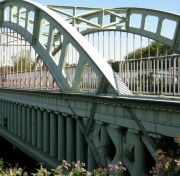George Leather

George Leather (1786-1870) of Yorkshire
1786 Born son of George Leather (1748-1818)
1809 Married Sarah Wignell
With his father (also George) he was responsible for colliery railways for the Fenton family of Rothwell Colliery and for the Surrey Iron Railway. Also worked on the Aire and Calder modernisation with his father and surveyed the River Derwent in 1810.
1810 Birth of his son John Wignall Leather
1821 Took over as resident engineer for Goole Docks
George Leather and Son of Leeds designed the Monk, Hunslet and Victoria bridges in Leeds
1828 George Leather of Leeds, Civil Engineer, became a member of the Institution of Civil Engineers.[1]
c.1839 Engineer for Goole Docks
In 1838 George Leather was approached by the Holme Reservoir Commissioners to manage the construction of their proposed reservoirs at Bilberry, Holme Stye, and Boshaw Whams.[2] Leather was not as closely involved in the day-to-day work as might have been expected. However, the Commissioners mismanaged the project, and appear not to have clearly defined Leather's terms of engagement, or to have paid him adequately.
In 1852 the dam at Bilberry Reservoir burst and millions of gallons of water poured down the Holme valley, causing considerable destruction to buildings and bridges, and killing around 80 people.[3]. This disaster seriously damaged George Leather's reputation.
1870 He died in his 84th year on April 2nd. Residence: Knosthorpe Hall, near Leeds[4]

